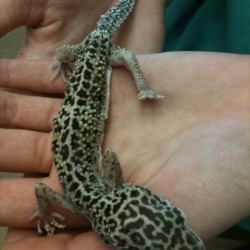A Hidden Killer!
Many reptile keepers dread to hear the word ‘Crypto’ and for good reason, as this is a parasite which can have devastating consequences and wipe out entire collections of reptiles in severe cases. Cryptosporidium infections are found in a wide variety of reptile species, and can cause severe debilitation and death in many, whilst being a commensal or harmless gut organism in others. The parasite is a protozoan single celled organism with a direct life cycle meaning the host becomes reinfected very quickly with the next generation of eggs contained in faecal material. The importance of this life cycle mode is that infection can spread very rapidly throughout reptile collections unless very strict hygiene and disinfection protocols are put in place. Because some animals may be subclinical carriers with no visible symptoms, by the time an animal is identified as infected the organism may have spread to many others in a collection. Infection can be mild and only cause short term diarrhoea or can lead to severe chronic diarrhoea, wasting, anorexia, failure to thrive and even death. Other signs of disease sometimes occur such as inner ear infections, reproductive failures and secondary infections such as stomatitis associated with immune debilitation. Cryptosporidia species infecting reptiles are not thought to be transmissible to humans, although we have two species that cause severe gastrointestinal illness of our own.
The first difficulty in treating this infection is that it is difficult to diagnose. Quite often it is impossible to detect on routine faecal analysis even with specialised staining techniques, hence the prefix ‘crypto-‘ meaning ‘hidden’. Many infected animals turn up negative on faecal tests as the parasite is an intermittent shedder, and can also exist in low numbers in the intestinal lining making it extremely easy to stay undetected. The other tests involve a PCR or ELISA test which detect the parasite DNA and are more sensitive but again this relies on the organism showing up in the sample to be tested. The only certain way to diagnose the parasite is on post mortem microscopic examination of sections of gut lining. The second reason it is problematic is that there are no treatments that are 100% reliable or effective. In fact, most reptiles that are showing clinical signs of cryptosporidiosis are already too debilitated to survive, and the treatments themselves may actually do more harm than good. Various treatments have been trialled including various classes of antibiotics, anti-parasitic drugs and even concentrated bovine serum preparations with limited success rates. In some cases, and specifically in large collections it may be necessary to humanely euthanase infected individuals as their prognosis is so poor, in order to safeguard the remaining non-infected animals. Identifying infected versus non-infected individuals can however be challenging.
For these reasons, it is vital that proper quarantine and isolation is carried out on new reptiles when adding to an existing collection. Strict hygiene practices that limit the spread of faecal contamination from one vivarium to the next will limit spread of infection. Particular caution must be taken with any wild-caught individuals, reptiles that are failing to thrive, or repeatedly refuse or regurgitate food, the latter being a common sign of infection in snakes. Leopard geckoes seem to be particularly vulnerable, although it is debatable whether this is due to genuine species susceptibility or due to the tendency towards large, intensive style husbandry conditions with many animals kept in close proximity at breeding facilities. Indeed, the biggest problems with Cryptosporidiosis in reptiles occur in large collections and breeding facilities so in these situaitions proper biosecurity measures and strict quarantine and testing policies should be put in place.
If you have a reptile that is showing any of the symptoms such as diarrhoea, inappetance, anorexia, weight loss or general ill thrift it is always wise to consult a trusted and experienced reptile veterinarian. Several other diseases can mimic signs of infection ranging from heavy roundworm or pinworm burdens, liver disease and intestinal impactions to more serious internal or metabolic problems. A good reptile vet should be able to outline a clear diagnostic and treatment plan based on the specific history and presentation on a case by case basis.

